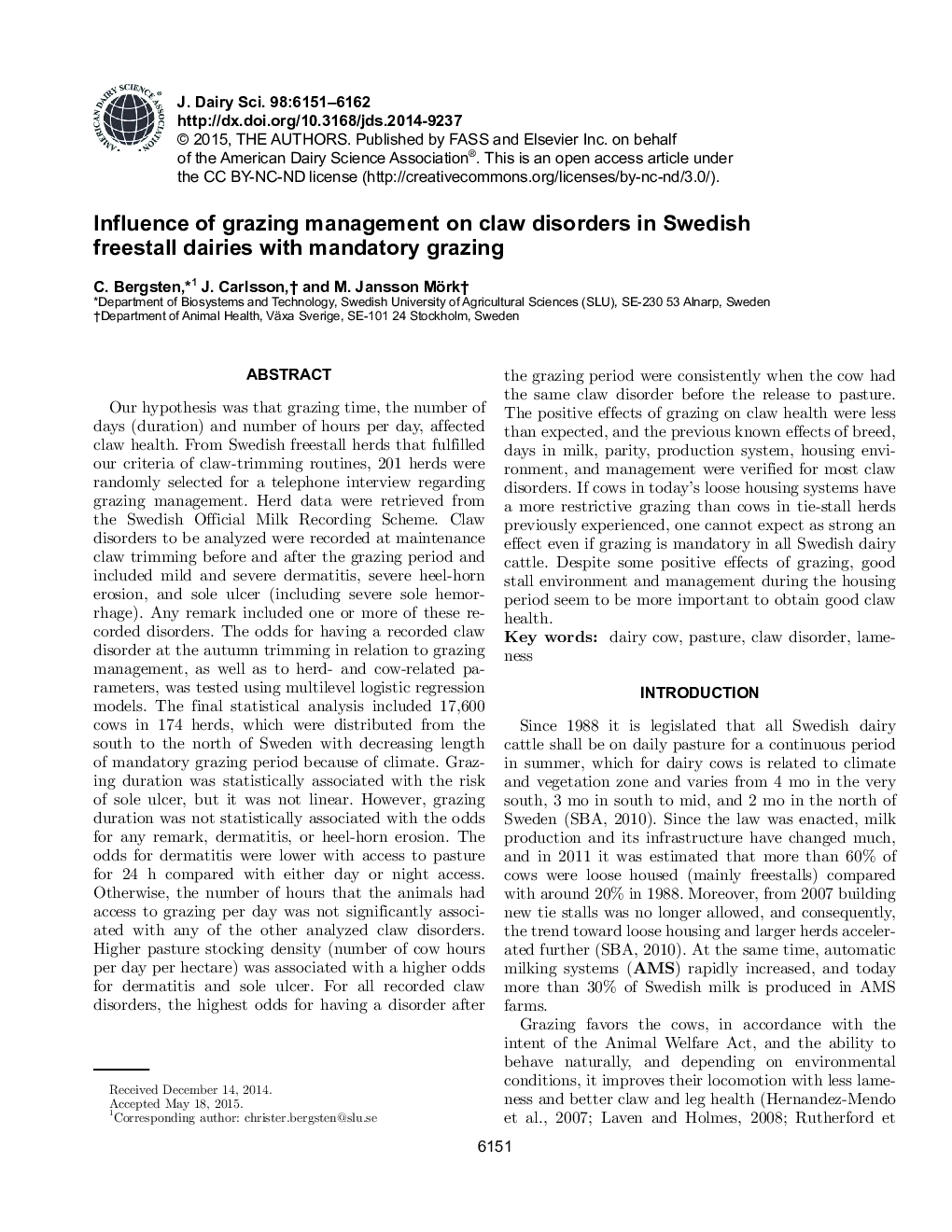| کد مقاله | کد نشریه | سال انتشار | مقاله انگلیسی | نسخه تمام متن |
|---|---|---|---|---|
| 10974319 | 1108024 | 2015 | 12 صفحه PDF | دانلود رایگان |
عنوان انگلیسی مقاله ISI
Influence of grazing management on claw disorders in Swedish freestall dairies with mandatory grazing
ترجمه فارسی عنوان
تأثیر مدیریت چرا در اختلالات پستان در لبنیات آزاد سوئد با چاشت اجباری
دانلود مقاله + سفارش ترجمه
دانلود مقاله ISI انگلیسی
رایگان برای ایرانیان
کلمات کلیدی
گاو شیری، مرتع، اختلال پستان، لنگش
ترجمه چکیده
فرض ما این بود که زمان چراور، تعداد روزها (مدت زمان) و تعداد ساعت ها در روز، سلامتی پنجه تاثیر می گذارد. از گله های آزادی سوئدی که بر پایه معیارهای ما از روش های برش پاره شده بودند، 201 گله به طور تصادفی برای مصاحبه تلفنی با مدیریت چراگاه انتخاب شدند. داده های گله از پروتکل ثبت رسمی شیر سوئد گرفته شده است. اختلالات پاره ای که باید مورد تجزیه و تحلیل قرار گرفت در برش پستان نگهدارنده قبل و بعد از دوره شیردهی و شامل درماتیت خفیف و شدید، فرسایش شدید پاشنه ساق و زخم تنها (از جمله خونریزی شدید تنها) ثبت شد. هر یک از جمله شامل یک یا چند مورد از این اختلالات ثبت شده بود. شانس برای داشتن اختلال پلاک ضبط شده در برش پاییز در رابطه با مدیریت چراگاه و نیز پارامترهای مرتبط با گاو و گاو با استفاده از مدل های رگرسیون چند لایه ای مورد آزمایش قرار گرفت. تجزیه و تحلیل آماری نهایی شامل 17،600 گاو در 174 گله، که از جنوب به شمال سوئد توزیع شده بود با کاهش طول دوره شیردهی اجباری به دلیل آب و هوا. مدت زمان گاو به طور معنی داری با خطر ابتلا به زخم همراه بود، اما خطی نبود. با این حال، طول دوره شیردهی به طور آماری با احتمال برای هر گونه فرسایش اشاره ای، درماتیت یا پاشنه آشنا نبود. شانس ابتلا به درماتیت با دسترسی به مرتع به مدت 24 ساعت در مقایسه با دسترسی روزانه یا شبانه کمتر بود. در غیر این صورت، تعداد ساعاتی که حیوانات در طی روز به آن دسترسی داشتند به طور قابل توجهی با هیچ یک از دیگر اختلالات پستان تجزیه نشد. تراکم بالای شکار مرتعی (تعداد گاوها در روز در هکتار) با احتمال بیشتری برای درماتیت و زخم تنها همراه بود. برای همه اختلالات ناقل ثبت شده، بیشترین احتمال وقوع اختلال بعد از دوره شیردهی، زمانی بود که گاو قبل از آزادی به مرتع، همان اختلال پستان را داشت. اثرات مثبت چاقی در سلامتی پستان کمتر از حد انتظار بود و اثرات شناخته شده قبلی نژاد، روز در شیر، زوج، سیستم تولید، محیط زیست مسکن و مدیریت برای اکثر اختلالات پستان تأیید شد. اگر گاوها در سیستم های مسکن شلوغ امروز گله های محدودتری را نسبت به گاوها در گله هایی که قبلا تجربه کرده اند، نباشند، حتی اگر چراغ در تمام گاوهای لبنی سوئدی اجباری باشد، نمی تواند به عنوان یک اثر قوی مورد انتظار باشد. علیرغم تأثیرات مثبتی بر روی چرا، محیط زیست و مدیریت خوب در طول دوره مسکن، برای دستیابی به سلامتی ناخن بسیار مهم است.
موضوعات مرتبط
علوم زیستی و بیوفناوری
علوم کشاورزی و بیولوژیک
علوم دامی و جانورشناسی
چکیده انگلیسی
Our hypothesis was that grazing time, the number of days (duration) and number of hours per day, affected claw health. From Swedish freestall herds that fulfilled our criteria of claw-trimming routines, 201 herds were randomly selected for a telephone interview regarding grazing management. Herd data were retrieved from the Swedish Official Milk Recording Scheme. Claw disorders to be analyzed were recorded at maintenance claw trimming before and after the grazing period and included mild and severe dermatitis, severe heel-horn erosion, and sole ulcer (including severe sole hemorrhage). Any remark included one or more of these recorded disorders. The odds for having a recorded claw disorder at the autumn trimming in relation to grazing management, as well as to herd- and cow-related parameters, was tested using multilevel logistic regression models. The final statistical analysis included 17,600 cows in 174 herds, which were distributed from the south to the north of Sweden with decreasing length of mandatory grazing period because of climate. Grazing duration was statistically associated with the risk of sole ulcer, but it was not linear. However, grazing duration was not statistically associated with the odds for any remark, dermatitis, or heel-horn erosion. The odds for dermatitis were lower with access to pasture for 24 h compared with either day or night access. Otherwise, the number of hours that the animals had access to grazing per day was not significantly associated with any of the other analyzed claw disorders. Higher pasture stocking density (number of cow hours per day per hectare) was associated with a higher odds for dermatitis and sole ulcer. For all recorded claw disorders, the highest odds for having a disorder after the grazing period were consistently when the cow had the same claw disorder before the release to pasture. The positive effects of grazing on claw health were less than expected, and the previous known effects of breed, days in milk, parity, production system, housing environment, and management were verified for most claw disorders. If cows in today's loose housing systems have a more restrictive grazing than cows in tie-stall herds previously experienced, one cannot expect as strong an effect even if grazing is mandatory in all Swedish dairy cattle. Despite some positive effects of grazing, good stall environment and management during the housing period seem to be more important to obtain good claw health.
ناشر
Database: Elsevier - ScienceDirect (ساینس دایرکت)
Journal: Journal of Dairy Science - Volume 98, Issue 9, September 2015, Pages 6151-6162
Journal: Journal of Dairy Science - Volume 98, Issue 9, September 2015, Pages 6151-6162
نویسندگان
C. Bergsten, J. Carlsson, M. Jansson Mörk,
